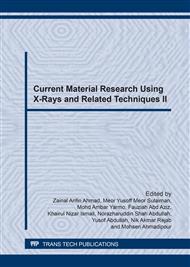[1]
P.N.D. Aza, A.H.D. Aza, P. Pena, S.D. Aza, Bioactive glasses and glass-ceramics, Bol. Soc. Esp. Ceram. 46(2) (2007) 45-55.
DOI: 10.3989/cyv.2007.v46.i2.249
Google Scholar
[2]
C. Tirapelli, H. Panzeri, E.H.G. Lara, R.G. Soares, O. Peitl, E.D. Zanotto, The effect of a novel crystallised bioactive glass-ceramic powder on dentine hypersensitivity: a long-term clinical study, Journal of Oral Rehabilitation. 38(4) (2011).
DOI: 10.1111/j.1365-2842.2010.02157.x
Google Scholar
[3]
S.A. Kumar, R. Pyare, Characterization of ZnO substituted 45S5 bioactive glasses and glass – ceramics, Journal of Materials Science Research. 1(2) (2012) 207-220.
DOI: 10.5539/jmsr.v1n2p207
Google Scholar
[4]
A.R. Boccaccini , M. Erol, W.J. Stark, D. Mohnc, Z. Hong, J.F. Mano, Polymer/bioactive glass nanocomposites for biomedical applications: A review, Composites Science and Technology. 70(13) (2010) 1764-1776.
DOI: 10.1016/j.compscitech.2010.06.002
Google Scholar
[5]
F.Z. Mezahi, A.L. Girot, H. Oudadesse, A. Harabi, Reactivity kinetics of 52S4 glass in the quaternary system SiO2–CaO–Na2O–P2O5: Influence of the synthesis process: Melting versus sol–gel, J. Non-Cryst. Solids. 361(1) (2013) 111-118.
DOI: 10.1016/j.jnoncrysol.2012.10.013
Google Scholar
[6]
I. Farooq, Z. Imran, U. Farooq, A. Leghari, H. Ali, Bioactive Glass: A Material for the Future. World J Dent, 3(2) (2012) 199-201.
Google Scholar
[7]
H.F. Yin, W. u. Chun, L.H. Mei, L.Y. Hsuan, L.M. Ru, Y.J. Lun, H.H. Wen, A biomimetic extracellular matrix composed of mesoporous bioactive glass as a bone graft material, Micropor. Mesopor. Mat. 212(1) (2015) 56-65.
DOI: 10.1016/j.micromeso.2015.03.027
Google Scholar
[8]
L.H. Larry., Bioactive Ceramic, Annals New York Academy of Science. 1(2) (1988) 54-71.
Google Scholar
[9]
N.R. Mohamed, E.D. Delbert, B.S. Bal, Q. Fu, B.J. Steven, F.B. Lynda, P.T. Antoni, Bioactive glass in tissue engineering, Acta Biomater. 7(6) (2011) 2355-2373.
Google Scholar
[10]
R.J. Julian, Review of bioactive glass: From Hench to hybrids, Acta Biomaterialia, 9(1) (2013) 4457–4486.
DOI: 10.1016/j.actbio.2012.08.023
Google Scholar
[11]
G. Daniel, D. Franziska, S.B. Delia, Bioactive glasses with improved processing. Part 1. Thermal properties, ion release and apatite formation, Acta Biomaterialia. 10(10) (2014) 4465-4473.
DOI: 10.1016/j.actbio.2014.05.019
Google Scholar
[12]
R.J. Julian, D.L. Peter, L.H. Larry, Hierarchical porous materials for tissue engineering, Phylosofical transaction of the royal society A. 364(1838) (2006) 263-281.
Google Scholar
[13]
E. Gentlemen, C.F. Yann, J. Gavin, L. Nasrin, D.O. Matthew, G.H. Robert, M.S. Molly, The effect of strontium-substituted bioactive glasses on osteoblasts and osteoclasts in vitro, Biomaterials. 31(14) (2010) 3949-3956.
DOI: 10.1016/j.biomaterials.2010.01.121
Google Scholar
[14]
M.N. Rasmussen, How glass change the world: the history and chemistry of glass from antiquity to the 13th century, Springer Science and Business Media, (2012).
Google Scholar
[15]
M.R. Majhi, R. Pyare, S.P. Singh, Studies on preparation and characterizations of CaO-Na2O-SiO2-P2O5 bioglass ceramics substituted with Li2O, K2O, ZnO, MgO, and B2O3, International Journal of Scientific & Engineering Research. 2(9) (2011).
Google Scholar
[16]
L.H. Larry, R. Niksa, B. M. Fenn, Bioactive glasses: Importance of structure and properties in bone regeneration, Journal of Molecular Structure. 1073(1) (2014) 24-30.
DOI: 10.1016/j.molstruc.2014.03.066
Google Scholar
[17]
O. Peitl, D.E. Zanotto, L.L. Hench, Highly bioactive P2O5-Na2O-CaO-SiO2 glass ceramics, J. Non-Cryst. Solids. 292(1-3) (2001) 115-126.
DOI: 10.1016/s0022-3093(01)00822-5
Google Scholar
[18]
D. Rohanova, R.B. Aldo, M.Y. Darmawati, D. Horkavcova, I. Brezovska, A. Helebrant, TRIS buffer in simulated body fluid distort the assessment of glass-ceramic scaffold bioactivity, Acta Biomaterialia. 7(6) (2011) 2623-2630.
DOI: 10.1016/j.actbio.2011.02.028
Google Scholar


